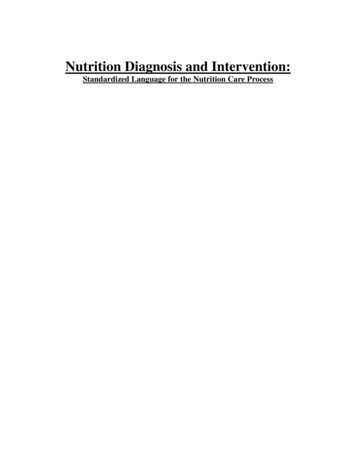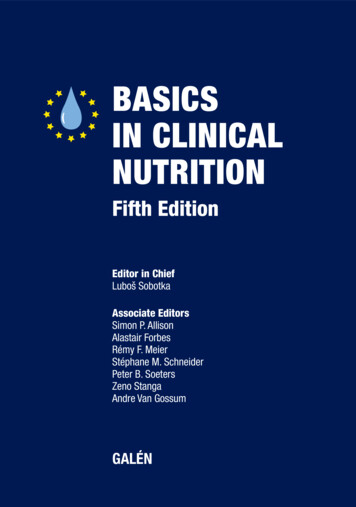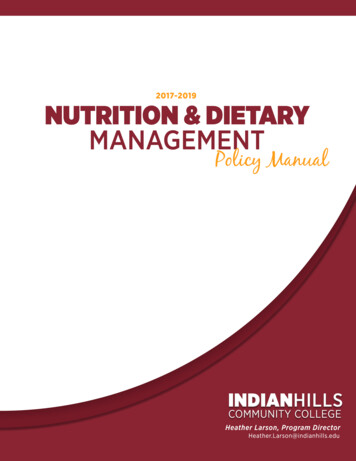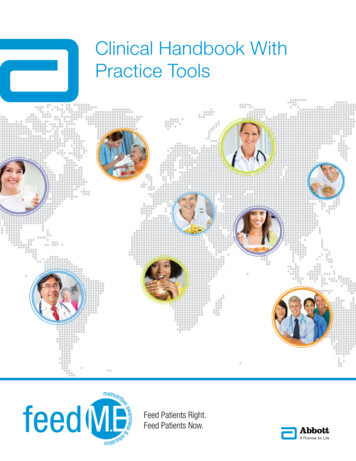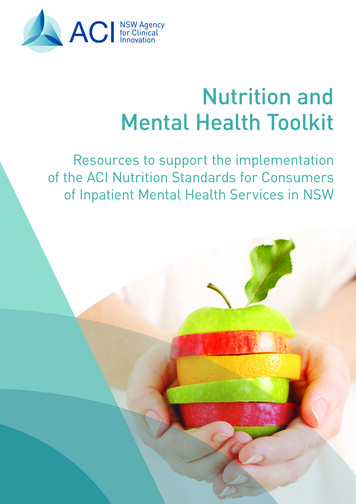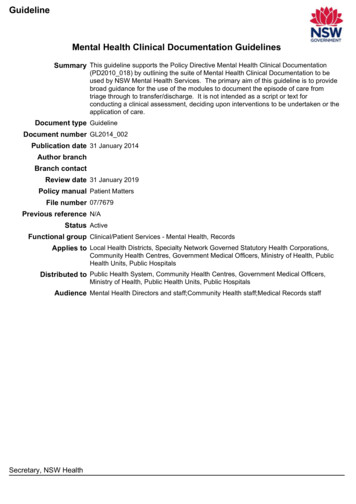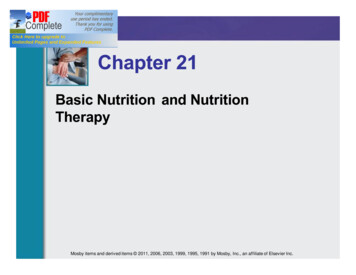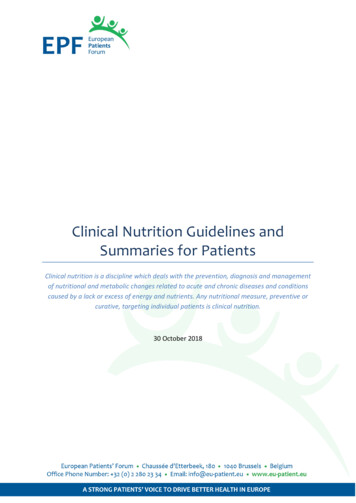
Transcription
Clinical Nutrition Guidelines andSummaries for PatientsClinical nutrition is a discipline which deals with the prevention, diagnosis and managementof nutritional and metabolic changes related to acute and chronic diseases and conditionscaused by a lack or excess of energy and nutrients. Any nutritional measure, preventive orcurative, targeting individual patients is clinical nutrition.30 October 2018
1.2.3.Introduction . 31.1What is this document about? . 31.2How was this document developed? . 41.3Who is this document intended for? . 4Nutrition in the prevention and management of chronic and long-term conditions . 52.1Medical nutrition: the patient-professional partnership . 82.2Health literacy and informed decision-making . 9Clinical nutrition guideline development . 103.1Guideline developers . 103.2Guidelines on clinical nutrition . 123.3Guideline developent processes . 14The ESPEN process for guideline development. 144.Patient involvement in guidelines development . 164.1 The extent of patient involvement in guideline development today and the needfor better guidance for patients, e.g. Patient summaries of guidelines . 164.2Patient expertise and experience . 184.3Patient generated nutrition data – an untapped resource. 195.Existing clinical nutrition guideline summaries developed by patients for patients . 206.Recommendations . 266.1Recommendations for guideline developers . 266.2Recommendations for patient organisations . 277.Conclusion . 278.Acknowledgements. 29Clinical Nutrition Guidelines and Summaries for Patients2
1.1WHAT IS THIS DOCUMENT ABOUT?This document is about the development of clinical nutrition guidelines and the importanceof summaries of these for patients as well as the need for patient involvement in thedevelopment processes, the importance of health literacy and informed decision-makingconcerning food and nutrition.The importance of food and nutrition for patients as well as the need for good informationto patients on food and nutrition is highlighted in EPF’s position statement on informationto patients on food and nutrition. 1 Please consider EPF’s statement when reading thisdocument.Clinical nutrition is a discipline which deals with the prevention, diagnosis and managementof nutritional and metabolic changes related to acute and chronic diseases and conditionscaused by a lack or excess of energy and nutrients. Any nutritional measure, preventive orcurative, targeting individual patients is clinical nutrition. Clinical nutrition includes thenutritional care of people with cardiovascular disease, obesity, diabetes, dyslipidaemias,food allergies, intolerances, inborn errors of metabolism as well as any disease wherenutrition plays a role such as cancer, stroke, cystic fibrosis and many more. 2This document explains existing clinical nutrition guideline development processes as well asoutlining shortcomings in existing processes and proposes how patient involvement in theguideline development process can be improved.It explains why patient summaries of clinical nutrition guidelines are needed and highlightsthe importance of patient involvement in the development of guidelines and patientsummaries alike.This document aims to inform organisations developing clinical nutrition guidelines how tobetter involve patients in this process. This document is also written to provide Europeanand national patient groups information on scientific nutrition guidelines available forspecific disease areas as well as existing examples of patient friendly summaries of thisinformation. Where necessary, relevant resources are mentioned where further informationcan be found.The objectives of this document are to: Underline the importance of information to patients on food and diet choicesEmphasise the importance of health literacy and informed decision-makingconcerning pdfESPEN guidelines on definitions and terminology of clinical rition.pdf12Clinical Nutrition Guidelines and Summaries for Patients3
Provide an overview of existing nutrition guideline development processes;Highlight evidence based scientific nutrition guidance available for specific diseaseareas, while giving examples of existing examples of patient friendly summaries ofthis information and nutrition guidance developed by patient organisations;Explain why patient summaries of clinical nutrition guidelines are needed and inspirescientific societies and guideline developers;Provide recommendations for improving existing guideline development processes,improving patient involvement and the development of patient summaries.1.2 HOW WAS THIS DOCUMENT DEVELOPED?Based on the outcomes of the EU Patient Group Conference on Nutrition 3 which took placein Brussels in June 2017 and in line with EPF’s position statement on information to patientson food and nutrition 4, in February 2018, EPF set up an EU patient task force on nutrition 5,made up of volunteers from the EPF membership as well as other EU patient organisations.The task force is facilitated and co-led by the EPF Secretariat and EGAN (Patients Networkfor Medical Research and Health).The main objective of this task force was to enhance the development of comprehensivesummaries of recognised nutrition guidelines for patients, following the request of thepatient community, in cooperation with scientific societies and guidelines developers. Thisdocument has also undergone consultation with the wider EPF membership.This document will be presented at the 2018 edition of the Optimal Nutritional Care for All(ONCA) Conference taking place in Sintra, Portugal in November 2018.1.3 WHO IS THIS DOCUMENT INTENDED FOR?This document is primarily intended for patient and carer organisations and also scientificsocieties and organisations developing clinical nutrition guidelines. Healthcare professionalswho are called upon to give advice may also find this document useful.DISCLAIMERThis document has no intention of providing individual patients and their caregivers withnutritional advice. It only describes general situations. For personal advice on nutrition oneshould consult a dietitian. Furthermore, the information included in this document is cal Nutrition Guidelines and Summaries for Patients4
Nutrition plays an important role in both health and chronic disease management. Indeed,for many people attaining good nutrition is not a simple question of having good eatinghabits or choosing the ‘right’ foods. Some medical conditions mean that even when aperson makes good nutritional and lifestyle choices, achieving nutritional health remainschallenging. It is also important to keep in mind that in some cases, foods or food elementscan also trigger the onset of specific diseases, for example food allergies and intoleranceand/ or food poisoning and infections.Making good choices about one’s diet is not just an important way to reduce the risk of theonset of chronic conditions and maintain health. Nutrition also has a key part to play in themanagement of a chronic condition and health outcome as well as in secondary preventionand prevention of multimorbidity. Appropriate nutrition can prevent certain symptoms,delay the onset of complications, and improve health outcomes for some patients. Eatingthe right kinds of foods can improve well-being and physical strength, whereas poornutrition can lead to reduced immunity, impaired physical and mental development, andreduced productivity.6 Moreover, depending on a patients’ condition, treatment, lifestyle,ability, age and environment, certain foods will be more appropriate for some patients. Inthese cases, nutrition should also be adapted according to the patient's needs. This is veryrelevant when a disease affects taste, often as a side-effect of the use of medication.For some types and phases of disease it is notpossible to maintain a normal nutritional statusand/or avoid disease symptoms with personaliseddiets and standard foods alone. In such casesspecialised nutritional products (medicalnutrition) are needed to supplement the diet, or toreplace food. In these cases, patients are partiallyor entirely dependent on medical nutrition.Medical nutrition products have been designedspecifically to meet these medical needs, providingenergy and nutrient-dense solutions in easilydelivered forms. Medical nutrition may be oral(oral nutritional supplements), enteral (via thestomach or intestine) or parenteral (via the vein).Such nutrition formulas are given through a special feeding tube (enteral) or intravenousESMO (European Society for Medical Oncology). Handbook on Nutrition and Cancer. Lugano: ESMO Press;2011. ECPC (European Cancer Patient Coalition). Living Well During Cancer Treatment. Brussels: ECPC; 2017.6Clinical Nutrition Guidelines and Summaries for Patients5
catheter (parenteral). Most often this can be done in a patients’ own surroundings (athome), however it is sometimes given in hospitals, especially in more critical periods.The examples below provide disease-specific explanations of the important role nutritionplays in the management of certain chronic conditions.Coeliac disease is a lifelong autoimmune disorder where gluten - a protein found in wheat,rye, oats and barley triggers an abnormal response of the immune system which causesdamage to the small intestine and left untreated can lead to malabsorption andmalnutrition. The immune reaction may affect other organs also, therefore coeliac diseasemay manifest with various symptoms outside the digestive system. The only availabletreatment for coeliac disease is a strict and lifelong gluten-free diet. Therefore, goodnutritional counselling is essential. Under the gluten-free diet, symptoms will improve inmost cases, the antibody levels will gradually normalise, and the intestine will mostlyrecover.Cancer patients are at a particularly high risk of malnutrition because both the disease andits treatments threaten their nutrition status (state of nourishment of a patient). Yet cancerrelated nutritional risk is sometimes overlooked or under-treated by clinicians, patients, andtheir families. Depending on the type of cancer and stage of treatment, guidance can differ.Additionally, cancer patients’ taste and ability to eat can also be significantly affected.Sometimes disease conditions malnutrition, due to lack of appetite, problems in swallowing,increased catabolism or caused by treatment; known as "malnutrition related to thedisease". For instance, people with throat cancer can have serious swallowing problems. 7There are two main types of diabetes, type 1 and type 2. There are some other types ofdiabetes too, such as gestational diabetes. Type 1 diabetes is a lifelong condition where theblood glucose (sugar) level is too high because the body cannot make a hormone calledinsulin. In Type 2 diabetes the blood glucose level is too high because the body does notproduce enough insulin, or the body cannot effectively use the insulin it produces. Insulinallows the glucose in the blood to enter cells and fuel our bodies. In addition to symptomsof diabetes, over a long period of time, high glucose levels in the blood can seriouslydamage the heart, veins and arteries, eyes (neurological complications), feet and kidneys.These are known as complications of diabetes. A key requirement in preventingcomplications is maintaining good blood glucose (glycaemic) control, blood pressure andcholesterol. Comprehensive nutritional information, education and training is imperative inorder for people with diabetes to be able to adequately manage their condition. This mayinclude calculating the amount of carbohydrates, recognizing hidden sugar within foodingredients and knowing the amount of salt and fats.Good nutritional care is a fundamental element of the management of Huntington disease,a hereditary, degenerative neurological condition. Weight loss is a well-known and 037bca4ddc890b934a3d1b460d/patient perspectives on nutrition -1.pdf7Clinical Nutrition Guidelines and Summaries for Patients6
problem experienced by many patients with Huntington disease. Many patients lose weightunnoticed due to high energy needs and other food or diet problems therefore guidance ondiet is essential.8Mucopolysaccharide Diseases (MSP) are rare or very rare hereditary metabolic diseaseswhich require a certain medical nutrition, a medical diet, which in most of these diseases isthe only way of treating them to avoid or at least delay damage of organs, mental andphysical disabilities and premature death. These diets must be prescribed and monitored byexpert healthcare professionals. Regular information and counselling to patients and theirfamilies are indispensable to enable patients to follow these very strict diets and encouragetheir continuous adherence.The so-called western lifestyle with changing nutrition, gut flora, air pollution, chemicals andprocessed food have been studied a lot in connection with the development of allergy andasthma. For food allergy, the only treatment is avoidance and people and families with foodallergy rely on food labelling. For some people with food allergy their diet is so restrictivethat clinical food supplements are needed to ensure good nutrition. Management of foodallergy always requires a mandatory nutritional guidance by a dietician or other healthcareprofessional. Severe food allergy can be highly limiting for patients and families and requireseducation of all actors in the food chain, including schools, catering, and restaurants.Asthma and chronic obstructive pulmonary disease (COPD) cause a chronic (systemic)inflammation of the airways, impaired lung function, airflow obstruction, morbidity andmortality. People with COPD can be at risk of fragility, because the disease, and the lack ofoxygen also consumes muscles. Therefore, and especially in severe COPD, clinical nutrition isneeded to ensure proteins, vitamins and minerals are provided. The disease also ‘consumesmore’ of these and therefore nutrition and professional support on diet is needed. Oftenpeople with COPD have other chronic diseases like diabetes or heart disease which alsocome with a specific dietary guidance.Chronic kidney disease can require a kidney friendly diet to prevent more kidney damage.People living with chronic kidney disease may need to limit fluids, eat a low protein diet,limit salt, potassium, phosphorus and other electrolytes. This can prevent certain mineralsbuilding up in the body.Cardiovascular disease - Consumption of long chain omega 3 polyunsaturated fatty acids,fish, fruit and vegetables, nuts, fibre and replacing saturated fats with polyunsaturated fattyacids are associated with beneficial heart effects while consumption of saturated fatty acids,trans fatty acids and salt are associated with an increased risk of cardiovascular events. AMediterranean dietary pattern is often recommended.Inflammatory bowel disease (IBD) (predominantly Crohn’s disease and ulcerative colitis) isincreasingly common and potential dietary factors have been suggested to be at are-for-hd-patients.pdfClinical Nutrition Guidelines and Summaries for Patients7
Malnutrition is highly prevalent in IBD, especially in Crohn's disease. Increased energy andprotein requirements are observed in some patients. These patients may need medicalnutrition in different phases throughout their lives, especially during the acute phase oftheir disease. 9Chronic intestinal failure (CIF) is the long-lasting reduction of gut function, below theminimum necessary for the absorption of macronutrients and/or water and electrolytes,such that intravenous supplementation is required to maintain health and/or growth. Eventhough it is very important that these patients maintain some ingestion of food andnutrients adapted to the characteristic of their intestine, they depend on parenteralnutrition (or iv fluids) to support their life.10Further detail on the importance of nutrition in the context of different chronic conditions ishighlighted in EPF’s position statement on information to patients on food and nutrition.2.1 MEDICAL NUTRITION: THE PATIENT-PROFESSIONAL PARTNERSHIPPatients and caregivers must be involved in decisions taken, together with healthcareprofessionals, regarding the need for nutritional assistance as well as medical nutrition. Tomaximise positive outcomes and to ensure patient safety, healthcare professionals, who areexperts in this area should make recommendations about initiating, monitoring andcessation of medical nutrition. EPF supports the notion of a Nutrition Support Team (NST),which is a multidisciplinary team consulted to manage the complex nutritional needs ofpatients (e.g. enteral and parenteral) which serves the primary responsibility of assuringthat patients receive optimal nutrition support. Core members can include doctors,dietitians, nurses and pharmacists. Activities range from direct patient care to thedevelopment of guidelines and protocols for implementation by other healthcare workers.Healthcare professionals should use evidence-based guidelines to assist them in selectingthe most appropriate method of nutritional support for their patient, taking account of awide variety of factors including: the goals of care, in a shared-decision making context patient’s nutritional needs and wishes ability to take, digest, absorb, metabolize or excrete foods, nutrients or metabolites diagnosis and prognosis patient’s ability to adhere to the line dfhttp://www.espen.org/files/ESPENGuidelines/1 ESPEN guidelines on chronic intestinal failure in adults.pdf910Clinical Nutrition Guidelines and Summaries for Patients8
patient safety and patient reported outcome measures (PROMs) and patient reportedexperience measures (PREMs) where relevantIt is essential that healthcare professionals combine their clinical experience and practicalexperience with a sound knowledge of the evidence base in making a recommendation or inthe provision of nutritional support, e.g. a patient with a poor appetite may not be able orwilling to consume extra food or may lack the energy or ability to prepare it. A patient whohas lost the ability to swallow may need enteral (via the stomach) addition of nutrition and apatient with intestinal obstruction may need parenteral nutrition (via the vein). Similarly,financial aspects such as adequate equipment to prepare food and / or cost of concentratefood should not be neglected.2.2 HEALTH LITERACY AND INFORMED DECISION-MAKINGReliable, understandable, relevant and easily accessible information is the cornerstone ofindividual patient empowerment, quality of life, diseases management and meaningfulpatient involvement in health policy.Health literacy is a key determinant of health.11“Health literacy is linked to literacy and entails people’s knowledge, motivation andcompetencies to access, understand, appraise, and apply health information in order tomake judgments and take decisions in everyday life concerning healthcare, diseaseprevention and health promotion to maintain or improve quality of life during the lifecourse.” 12Being health literate empowers patients to understand information about their health andmake more informed decisions. Low health literacy, or the lack of health literacy-friendlyinformation can make daily life choices difficult for patients.In the nutrition arena, health literacy-friendly measures recommended by WHO includemaking relevant and understandable information available from reliable sources. 13It is important that research, guidelines, care standards, recommendations and goodpractices concerning nutrition reach patients and citizens. Research and guidelines shouldbe explained and disseminated in a patient-friendly way, and their communication anddissemination should be improved. Patient organisations, healthcare professionals,governments and the wider education system, all have their specific roles to play in this areaif we are to improve health awareness and maximise impact upon the health and lifestylechoices of future generations.According to the Value project definition, meaningful patient involvement means thatpatients take an active role in activities or decisions that will have consequences for 86/1471-2458-12-8013Health Literacy. The solid facts. WHO Europe, 2013, page 41-42, link1112Clinical Nutrition Guidelines and Summaries for Patients9
patient community, because of their specific knowledge and relevant experience aspatients.14 Patients and patient organisations are best placed to advise on what mattersmost to patients, how to define messages, in what form these should be delivered, throughwhich channels they should be communicated, and finally on accessibility issues for patientswith disabilities.3.1 GUIDELINE DEVELOPERSAccurate information on specific nutritional needs is often not easy to find and sometimespatients and their caregivers do not receive appropriate guidance or answers to theirquestions from health care professionals. In addition, patients also sometimes find itdifficult to get a referral to a specialised dietitian for their questions on food and nutrition.Insufficient time and material dedicated to this in educational curricula of health careprofessionals can be an important cause for this lack of information. There is progress, but itis the complexity of the issue in particular that is underestimated.However, there is increasing interest from health care professionals in the topic of food andnutrition. Also, there is a growing number of professionals trained on matters of food andnutrition and their impacts on human health. Qualifications and professional terminology(i.e. nutrition scientist, public health nutritionist, dietitian, nutritionist, clinical nutritionist,and sports nutritionist) are different in different countries as is the level of education theyreceive. 15 In this document, we refer to all qualified nutrition professionals. 16Nutrition guidelines are very often developed by national scientific bodies, societies andinstitutions considering national circumstances, regulations, stakeholders etc. and makingrecommendations on the national level. At a European level, several societies andorganisations work with national affiliates to develop European nutrition guidance.Consequently, patients seeking information about nutrition are advised to also consultnational guidelines because they may vary or complete higher-level guidelines according tonational regulations. It is not possible here to provide examples and links for every countryhere, however the following section aims to give an overview of some of these guidelinedevelopers.The European Society for Clinical Nutrition and Metabolism (ESPEN) 17 is one of thescientific organisations that aims to encourage the rapid diffusion of knowledge and valueplus/doc epf handbook.pdfDoctors receive on average 25 hours of nutrition education in Europe (Eu J Cin Nutr 2014) compared todietitians who spend over 3 years studying nutrition and diet.16Please consult professional registers to find qualified professionals for advice.17www.espen.org1415Clinical Nutrition Guidelines and Summaries for Patients10
application in the field of clinical nutrition. One of its core activities is the organisation ofconsensus papers and guidelines about clinical nutritional care. National level ESPEN-likeorganisations18 have a similarly important role.Another important professional organisation is the European Federation of theAssociations of Dietitians (EFAD). 19 EFAD has developed a Life Long Learning (LLL) Strategyto promote the development of the dietetic profession and developing dietetics on ascientific and professional level. One of EFAD’s members, the British Dietetic Association(BDA) has developed several lay fact sheets for citizens and patients as well as familymembers and caregivers.20Another important resource is the Nutrition and Diet ResourcesUK website 21, a not-for-profit provider of nutrition and diet resources to support patientcentred care.Disease-specific professional organisations or research networks such as United EuropeanGastroenterology (UEG)22, the European Society for Paediatric GastroenterologyHepatology and Nutrition (ESPGHAN)23, the European Crohn s and Colitis Organisation(ECCO) 24, the European Society for Medical Oncology (ESMO) 25 and the EuropeanHuntington’s Disease Network (EHDN)26 also have an important role in developingtherapeutic guidance, protocols and evidence-based clinical guidelines.In Germany, the Association of the Scientific Medical Societies (AWMF) (Germanequivalent to NICE), is “a network of Scientific Medical Societies, which advises thegovernment of the Federal Republic of Germany as well as the governments of the Germanfederal countries ("Bundesländer") in all topics of scientific medicine and medical researchand classification.” They do this in many ways, including the publication of clinical nutritionguidelines with specific indications. 27The National Institute for Health and Care Excellence (NICE) in the UK is an independentpublic body that provides national guidance and advice to improve health and social care inEngland. NICE guidance offers evidence-based recommendations made by independentCommittees on a broad range of topics. The NICE clinical guidelines recommend howhealthcare professionals should care for people with specific conditions. They can cover anyaspect of a condition and may include recommendations about providing information ww.bda.uk.com/foodfacts/home21www.ndr-uk.org and more general information at s://www.awmf.org/en/awmf.html; es.html;1819Clinical Nutrition Guidelines and Summaries for Patients11
advice, prevention, diagnosis, treatment 28and longer-term management. These guidelinesare also important for health service managers and commissioners of national health systemservices. A general overview of developed guidelines can be found on their website.29Nutrition is also referred to in guidelines pertaining to specific environments, such as insurgery for example. 30 Although malnutrition accompanies many chronic diseases, it is alsoimportant to recognise situations such as surgery where nutrition has an important impacton the recovery of patients. The Enhanced Recovery After Surgery (ERAS) Society 31 has insome cases published guidelines as a joint effort with other medical societies such as ESPENand the International Association for Surgical Metabolism and Nutrition (IASMEN). 32Disease-specific patient organisations also publish guidance and information for patients.Many of which work with dietitians and medical doctors to check and verify the informationprovided. Some patient organisations have also developed evidence-based nutritionguidelines for health care professionals. 333.2 GUIDELINES ON CLINICAL NUTRITIONThis section gives a couple of examples of European and national guidelines on clinicalnutrition. This section on guidelines is illustrative, rather than exhaustive.Guidelines on the use of clinical nutrition 34 that aim to prevent, manage and treat differentchronic diseases and improve patient outcomes have been developed by The EuropeanSociety for Clinical Nutrition and Metabolism (ESPEN) since 1997. These guidelines areintended for health care professionals and should be used as guidance for taking d
4 Clinical Nutrition Guidelines and Summaries for Patients Provide an overview of existing nutrition guideline development processes; Highlight evidence based scientific nutrition guidance available for specific disease


